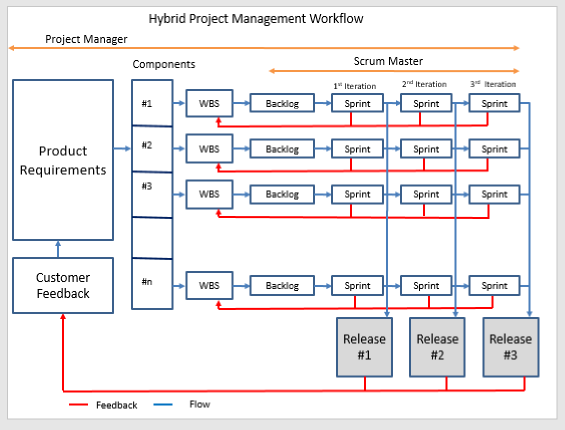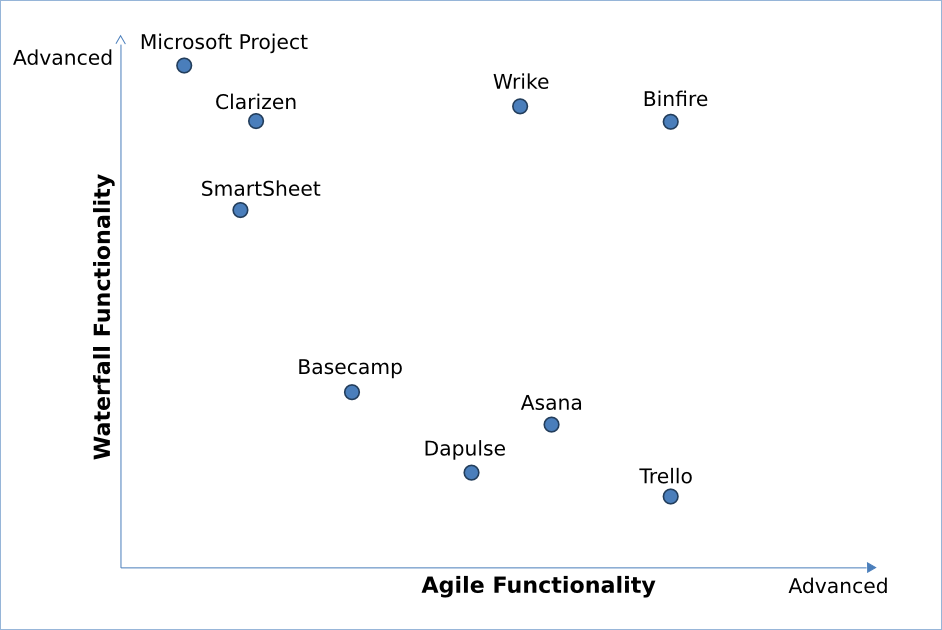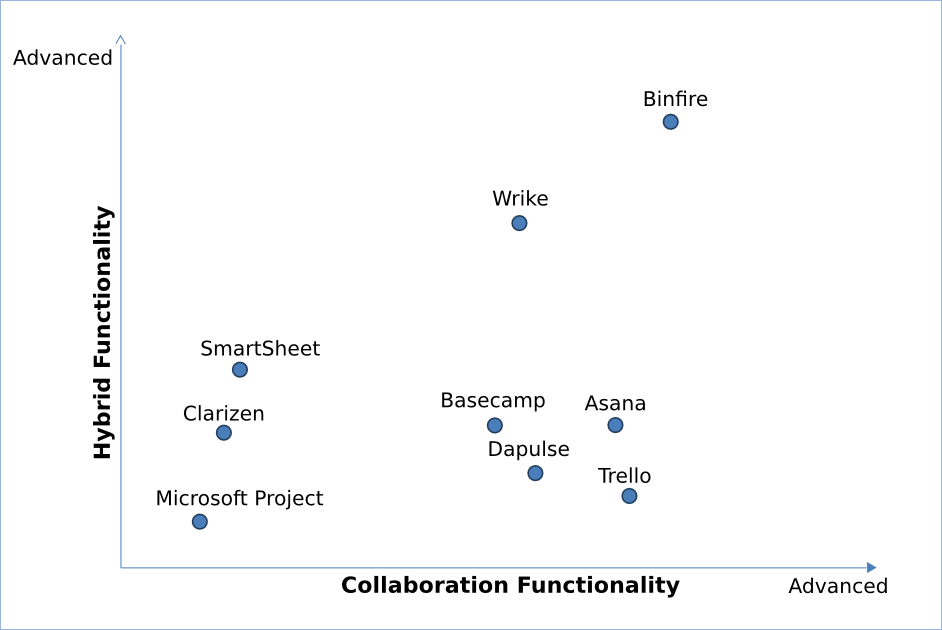Introduction
In recent years there has been a significant increase in popularity of Agile methodologies at the expense of Waterfall. Both Agile and Waterfall have their strengths and weakness and each is suitable for different scenarios. In fact, many organizations attempt to use different aspects of Agile and Waterfall.
This Hybrid Project Management Manifesto formalizes some of the practices of practitioners who combine both methodologies.
We will cover the following topics:
- The Guiding Principles for Hybrid
- Roles and Responsibilities for Project Managers and Scrum Masters
- Hybrid Processes
- Assessment of Hybrid Enabling Software
- Frequently Asked Questions
Definition
Hybrid Project Management combines the formal and Agile methods to create a new project management method. Hybrid employs the thoroughness of Work Breakdown Structure (WBS) with speed and lean benefits of Agile for a new project management method which is both detailed and fast. Most projects benefit from using Hybrid project management method. Only very small projects don’t require hybrid method.
Guiding Principles
- A Hybrid project is managed by a Project Manager using WBS methodology who has overall ownership and responsibility for the project.
- Scrum Masters support the Project Manager by executing each Agile Sprint.
- Continuous Team Collaboration is required for ongoing reporting, analysis and management review.
Role and Responsibilities
- Hybrid is independent of management structure and there is no requirement for a formal Project Management Office (PMO). The PMO adds another layer of bureaucracy, causes delays and expense and is not compatible with Agile
- The Project Manager assumes the role of a Product Manager. There is only Project Manager or product manager in Hybrid project management method. He or she is considered the business owner of the project.
- The Project Manager and Scrum masters share direct responsibility for different segments of the project.
- The Project Manager has overall project responsibility and ownership over the project.
- Project Manager is primarily concerned with the front end of the project flow (product requirements, customer feedback, components definition and WBS)
- Scrum Masters are responsible for backend of project flow (backlogs, sprints and releases).
- Project Manager creates a team consistent of Scum Masters and other management staff (if need).
- Each Scrum Master builds his or her team based on requirements and time frame for delivery.
Hybrid Project Flow
Below is a schematic of hybrid project management flow is shown. Refer to this schematic for reference for terms used throughout this paper.

Figure 1- Hybrid project management flow schematic
Definitions
- Components: The individual building modules driven from product requirement document. For example, a mobile phone has electronics, display, WIFI and software components. A software product may have UI, Business Logic and communication components. Product requirements establish which components are needed in a project.
- Track: The path for development and release of each component. Some tracks could be shorter or longer than others.
- Backlogs: The list of tasks for each component. Tasks for each sprint are derived from backlog of the same track. Both project manager and scrum masters add or modify the backlog.
- Sprint: 4-8 weeks long development effort and each includes development, testing and release (deployment). Each track has its own backlog and sprints. Sprints from different tracks run in parallel. The output of each sprint from different tracks may or may not combine with sprints from other tracks to make it into a release
- Project Team: Each project team is made up of dedicated team members. The essential members are 100% assigned to the project, and there is no sharing of resources across multiple projects. Team members report to scrum masters for day to day development effort.
Hybrid Planning Phase
In Waterfall, the entire project plan is scoped and planned before the start of the project. In Agile, only the first sprint is planned. Hybrid Project Management requires a complete project plan but the specific details of each sprint is not defined until the first sprint is completed. The Project Manager has overall Planning responsibility and each Sprint is managed by the Scrum Master.
| Project Task | Definition | Responsibility | |
|---|---|---|---|
| Project Manager | Scrum Master(s) | ||
| The Project Manager defines the project goals for a given timeframe. There is an overall goal which is set and then there are sub-goals such as product features. The delivery date for these features are set in advance. | |||
| Once the goal has been defined, the tasks required to develop the specific features, functionalities and user-stories are detailed. The Project Manager has overall ownership of this phase, and the Scrum Masters provide details on how each Sprint will be implemented. | |||
| There is a joint responsibility between the Project Manager and each Scrum Master to break down each project phase into tasks and determine how long it will take for each phase to complete. | |||
| With the time estimates provided by each Scrum Master, the Project Manager creates the overall schedule. In many projects there are dependencies between tracks and here project manager and scrum master work together to build the overall schedule. | |||
| With Development Start, the Scrum Master owns the duration of the Sprint: Start, Test, Finish and Review. | |||
| The Project Manager is responsible for reviewing the results of the Sprint. If there needs to be changes or modifications to the next Sprint, this is the responsibility of the Scrum Master. | |||
Hybrid Process
Hybrid follows the Agile methodology. At each iteration, customer feedback is sought, testing occurs and fixes made to enable continuous improvement. Formal method is used to define the outcome for each iteration.
| Project Task | Definition | Responsibility | |
|---|---|---|---|
| Project Manager | Scrum Master(s) | ||
| With each iteration, there is quality improves with the design, analysis and testing. Quality Control is based on detecting and fixing bugs that occur at each iteration. | |||
| Lessons learned from each iteration are applied to the next Sprint. | |||
| Risk detected and resolved at each iteration. | |||
| After each iteration the overall validity of the project and its procedures are analyzed. | |||
| Customer feedback is solicited after the release of each iteration and used to modify plans for next sprints. | |||
Hybrid Execution
In Hybrid the Project Manager is assigned the overall project ownership, and the individual Scrum Master is responsible for executing Sprint. Reporting is a joint responsibility requiring continuous collaboration and communication.
| Project Task | Definition | Responsibility | |
|---|---|---|---|
| Project Manager | Scrum Master(s) | ||
| Project Manager owns the entire project. Individual Scrum Masters own each iteration. | |||
| Project Manager develops WBS with help of Scrum Masters. Scrum Master perform Task Assignment for each sprint. Backlog is managed by project manager and Scrum Masters. | |||
| Weekly project meeting to review status of overall project plan. Daily standup Sprint meeting is managed by each Scrum Master. | |||
| Daily status reporting by each Scrum Master and weekly brief to management by Project Manager. | |||
| Daily testing by dedicated Q&A team and developers. Regression testing is conducted before each version release. | |||
Hybrid Enabling Tools
Hybrid Project Management is supported by method and knowhow that include the following components:
- WBS: Work Breakdown Structure, which uses such tools as Gantt chart, subtasks, milestones and dependencies to define a project completely.
- Agile: Kanban Board for showing each task’s position during the project development cycle.
- Collaboration: Real time status notifications and updates to the entire team and integration into high level project plans to management review at any time.
The graphs below map out some of the leading software vendor capabilities as it relates to Hybrid.

Figure 2- Waterfall versus Agile Functionality

Figure 3- Hybrid versus Collaboration Functionality
| Software Vendor Hybrid Functionality Assessment | |||
|---|---|---|---|
| Functionality | |||
| Waterfall | Agile | Collaboration | Hybrid |
| Asana | |||
| Basecamp | |||
| Binfire | |||
| Clarizen | |||
| Dapulse | |||
| Microsoft Project | |||
| Smartsheet | |||
| Trello | |||
| Wrike | |||
Frequently Asked Questions
Question. Is hybrid a new methodology?
Answer. No Hybrid is not a new methodology, but a fusion of two old methodologies. It has been practiced by experienced project managers for many years under different names. Recently the name “Hybrid Project Management” has gained acceptance.
Question. Is this a formal methodology?
Answer. Yes. Hybrid is a formal methodology and is gaining traction with both academia and professionals.
Question. How is Hybrid different from Structured Agile?
Answer. It is the same methodologies with two different names. “Hybrid” project management is a better description of the underlying methodology.
Question. Is this a new methodology or just another way of saying we use Agile and Waterfall based on the particular situation?
Answer. It is a new way of doing things, having a short focus on product features and a long focus on the final result.
Question. Is there a risk of not doing either Agile or Waterfall properly?
Answer. No, in fact, it reinforces doing both better and more professionally.
Question. Is Hybrid more relevant for any particular industry or type of project?
Answer. All industries can use Hybrid. For very short projects of less than 3 months, it is better to use Agile only.
Question. Does Hybrid work in an organization of all sizes?
Answer. Yes, it is not a function on the size of the team or organizations. In fact, even long term personal projects could use Hybrid.
Question. Are there any particular challenges using Hybrid in remote teams?
Answer. NO, exact set of challenges like all other methodologies
Question. Does Hybrid require special training? (Most people are not trained on both Agile and Waterfall, so how do you bridge the two?)
Answer. Yes, if people are trained on both Agile and Waterfall there is less to learn. The challenge is to get into the mindset of having sprint for short term delivery and organizing for the long-term product success.
Question. What are the advantages and disadvantages of Hybrid?
Answer. Advantages are that makes product delivery faster, exposes issues much earlier and the final result is always better. There are no major disadvantages.
Question. Is there any particular project management software best suited to support Hybrid?
Answer. Yes. You need a project management software that integrates both Agile (Kanban, Scrum etc.) and Work Breakdown Structure (WBS).
Question. Can you talk about your experiences using Hybrid and how that differed from using other methodologies?
Answer. In the past twenty years, I have used Hybrid on small and large projects with great success. This has enabled us to deliver product enhancements every month. At the same time, we can focus the final goal without getting distracted.
Question. Are there any specific metrics to measure Hybrid?
Answer. Like all other methodologies, time to market, cost, and quality of output.
